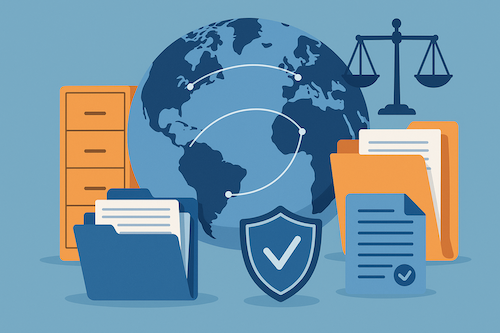
Table of Contents
Operating across borders brings immense opportunity, but let’s be honest, it also throws some serious curveballs. This is especially true when it comes to managing company records. Multinational organizations today face an increasingly tangled web of records retention policies. Forget simple, one-size-fits-all approaches. The global landscape of data governance demands sophisticated, adaptable strategies built right into the core of our enterprise systems.
The Global Compliance Maze: Why It’s So Tricky
Navigating multinational records management isn’t just about storing files for ‘X’ number of years. Different countries impose dramatically varied, sometimes conflicting, requirements. What flies in Germany might be non-compliant in Brazil or Singapore. As technology professionals tasked with designing or managing enterprise systems, we need to build flexibility right in. This enables systems to juggle multiple regulatory frameworks simultaneously without breaking a sweat (or the law).
Think about the key regions:
- Europe & North America: Regulations like the EU’s GDPR and state-level rules like California’s CCPA aren’t just suggestions. They mandate precise data handling, access control, and deletion protocols. They often emphasize data subject rights, requiring systems to locate and manage specific individual records efficiently. This necessitates granular control mechanisms within enterprise systems that can adapt not just to the country but sometimes even specific regional requirements.
- Asia-Pacific Variations: Glance across the Pacific, and the picture gets even more diverse. Countries like Japan, China, South Korea, India, and Australia each present unique challenges. Data localization rules (requiring certain data types to physically stay within national borders), specific retention periods for certain industries, and distinct consent management mandates mean our technological solutions need built-in smarts. Think region-specific metadata tagging, adaptable storage protocols, and workflow engines that understand these nuances.
Trying to apply a single, rigid retention schedule globally? It’s a recipe for non-compliance and potential hefty fines.
Bridging the Gap: Tech Meets Legal
So, how do we tackle this complexity? Effective records retention isn’t solely a tech problem or a legal problem. It demands deep, ongoing collaboration between technology teams and legal/compliance departments. It’s about building bridges. Risk assessment becomes a dynamic, iterative conversation, not a one-off checklist exercise.
What does this collaboration look like in practice? It often involves creating detailed compliance maps. Technology teams need to work hand-in-glove with legal experts. They chart out specific retention periods, access controls, legal hold requirements, and deletion protocols. These must be applicable in each relevant jurisdiction for different types of records (financial, HR, customer, etc.). This isn’t just about knowing the rules; it’s about translating them into functional system requirements. Furthermore, robust documentation and tracking are essential for audit preparedness. Systems need to generate comprehensive audit trails automatically. This demonstrates proactive compliance and systematic information management when regulators come knocking. Can you quickly prove when a record was deleted and why based on policy? You’d better be able to.
Making Enterprise Systems Compliance Engines
This means our enterprise systems need to be more than just digital filing cabinets. They need to function as intelligent, strategic compliance engines. What technical capabilities are essential? My research points towards systems incorporating features like:
- Geographically-aware data classification: Algorithms that can automatically identify the likely origin or relevance of data and tag it accordingly.
- Adaptive retention rule sets: Policies that aren’t hardcoded but can be dynamically applied based on data type, jurisdiction, creation date, and other metadata.
- Multi-jurisdiction compliance verification: Mechanisms that can check if a record meets the retention requirements of all applicable jurisdictions before allowing deletion.
- Legal hold automation: Workflows to easily identify, preserve, and manage records subject to litigation or investigation, overriding standard deletion schedules.
Technological frameworks must evolve beyond simple storage and retrieval. They need to actively manage the information lifecycle according to complex, overlapping rulesets. This transforms potential regulatory headaches into a demonstration of sound governance, which can even become a competitive advantage.
Building a Future-Proof Information Governance Strategy
Ultimately, successful multinational records retention boils down to a holistic approach. It’s a blend of regulatory intelligence (understanding the rules), cross-functional collaboration (tech and legal speaking the same language), and adaptive technological frameworks. It’s about building resilient, future-proof information management strategies from the ground up.
What are the biggest records retention hurdles you see multinational companies facing? Let’s swap insights over on LinkedIn.